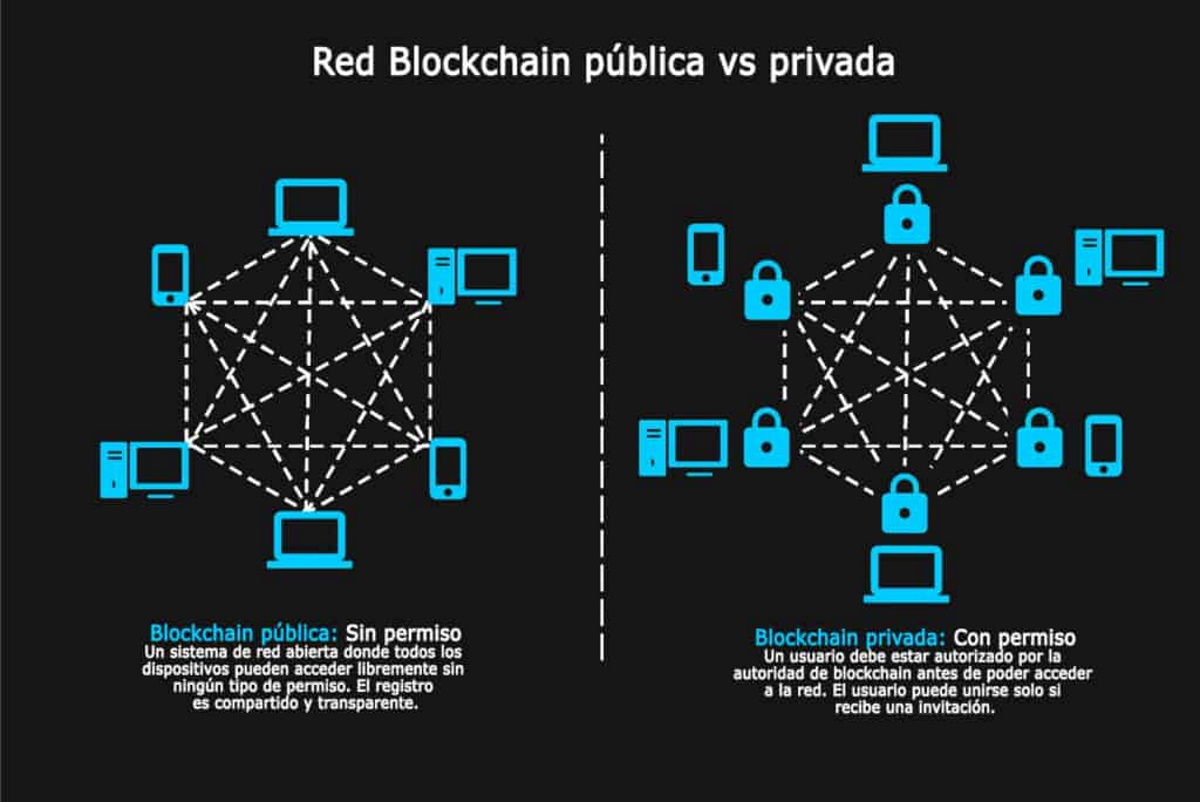
We have talked several times in our publications how blockchain is gaining popularity for many applications that companies can use in a wide range of networks, and then, extrapolating, many cities are implementing it as management mechanisms for urban services. To the general public, this technology is best known for its central role in cryptocurrencies, but blockchain has many more uses.
In general, blockchain networks can be used and customize their functionality and adapt to any need a company, city or industry may have. Perhaps the technology may seem confusing at first, but understanding its potential comes from knowing that blockchain essentially falls into two broad categories and four unique types of networks.
Categories of blockchain networks
Blockchain networks are generally divided into two categories: permissioned and permissionless. Each of the four unique types can fall into either of these categories, although some may include both.
Smart Cities considering adopting blockchain technology for managing any of their services should start by deciding whether a permissioned or permissionless network suits them best. Networks in these two broad categories operate differently and have their advantages and disadvantages.
Permissionless networks
Permissionless blockchain networks are probably the first thing that comes to mind when most people think of blockchain today, as they are the ones that have made the strongest entrance into our lives thanks to their visibility with the new economic solutions they bring. They are the classic decentralized ledger that has become famous with cryptocurrencies. In this type of blockchain, anyone can join the network, creating new data nodes that participate in the management and operability of the network. Everyone in the network is anonymous, and there are no rights restrictions from one node to another. The choice of this type of network for smart city services can be useful when implementing processes, for example, in which citizens are allowed to participate in municipal initiatives in which everyone has access to all the parameters and data.
Blockchain networks without permissions are usually more secure than those with permissions because they are decentralized. There are so many nodes that it is difficult for any bad actor to inflict damage to the entire system. They are open source and easier to access, so there is also a level of transparency that increases reliability. Everyone can see every transaction on the blockchain, even if they can’t see who made it and in the face of municipal governance, as this can encourage citizen participation in some of the city management processes.
Of course, this is a double-edged sword. For some companies, individuals, government agencies or system users, transparency of networks without permission may be too great a compromise to privacy. On the other hand, it is also true that they tend to be such large networks that they tend to operate much more slowly, as having so many nodes and users connected means that the networks take longer to process data, which is not energy efficient.
Permission-based networks
Permissioned blockchain networks are less decentralized and open, with restrictions on who can access what. Users can only work on certain nodes, and only certain people can validate transactions. Their identities are not anonymous on the blockchain. This is useful in Smart Cities where it is necessary for the different providers of a service to know each other, or at least not be anonymous, and where everyone involved in managing the infrastructure is aware of who is doing what on the network and what data they are sharing.
Many companies, industries, businesses or municipal governments prefer permissioned blockchains for Smart Cities management because they have much more privacy than permissionless networks. They are more secure in their own way, as only certain users can create, edit and validate transactions. If it is not necessary for the entire citizenry to act or have access to manage certain elements, as the number of nodes is limited with this type of network, as is the number of users, so permissioned blockchain networks also work faster than permissionless networks.
However, on the flip side, it is worth noting that the limited number of nodes can make them vulnerable to attacks, as they are more contained.
TTypes of blockchain networks
Therefore, based on this permission or non-permission parameter, we can also classify blockchain networks into different types:
- Public blockchain
The first of the four main types of blockchain networks is the public blockchain. This is the only type of completely permissionless network and the most commonly used type for cryptocurrency applications. One of the main advantages of this distributed ledger technology is the inherent security.
The ledger is open source and is not stored in one place. Everyone who has access to it has their own copy, so it is very difficult to destroy any of the data on the public blockchain. Once a transaction is validated, it cannot be altered. For Smart City managers using public blockchain for some citizen service, this involves many computers connected to the blockchain validating their transactions and confirming that all data is legitimate. This requires significant computing power and is notoriously energy intensive.
In fact, the entire cryptocurrency community faces controversy over the carbon emissions generated by verifying blockchain transactions on all these computers and it is possibly not the most efficient way to manage a smart city that seeks precisely to lessen its impact on the ecosystem. The slow processing speed and the immense computing power required are the main drawbacks of a public blockchain.
The most common applications of public blockchain networks for Smart Cities can be the validation of documents, using for example smart contracts for the rapid execution of some citizen requests for duplicate registration forms, or certificates of various kinds.
- Private blockchain
Private blockchains, also known as managed blockchains, are networks with restricted access permissions and user rights. They are pseudo-centralized in the sense that a single authority can control them, which is useful for a city’s technical or management team to use securely. Unlike public blockchains, these networks do not use open source and only authorized users or nodes can view, create, edit or validate data as determined by the party overseeing the system.
Private blockchain networks are often an attractive option for companies and industries that are part of a smart city ecosystem. A company can use this technology by restricting who can see its network, even keeping competitors out of its data. Private blockchains also run much faster than public versions because there are fewer nodes to work with.
Of course, critics of these networks say they can be less secure. Any knowledgeable user can analyze the open source code of a public blockchain and find and fix bugs and security vulnerabilities, which, speaking of services that the city has to manage for the greater good of all citizens, can be a problem. This does not happen in a private network. Companies that use such networks should be responsible for ensuring their secure design and operation.
It should also be recognized that the smaller number of nodes in private networks can be a vulnerability in itself. This concentration means that there is more risk if any of them go offline, and it may be easier for a hacker to cause serious damage if they break into the Smart City network and take control of any of its nodes or computer systems.

- Hybrid blockchain
Some blockchain networks have aspects of both permissioned and permissionless versions. These are hybrid blockchains. This type of network can strike a good balance because they offer many key blockchain benefits for businesses, industries or cities, such as the ability to use smart contracts and quickly verify transactions, for example in Smart Grid management by verifying the electricity consumption of all utilities connected to the grid and dumping the readings on the blockchain. They do this without being completely open or public.
Hybrid grids have a central authority, in this case, it could be the utility, but at least some of the nodes are open for public validation, which adds a level of transparency without giving up control. People can use the network to view their consumption data without having the access necessary for a hostile takeover. Some nodes and transactions can be made public while others cannot. This configuration decision is up to the controlling authority.
There are many applications for hybrid blockchains. They are already gaining popularity in real estate, but they also have use cases in healthcare, government and retail. For example, citizens could vote on a hybrid blockchain, where legitimate identities and votes are impossible to duplicate or forge. Election officials could then view and validate the data without the risk that they could tamper with anything in the process.
Similarly, a hybrid blockchain in healthcare could allow medical staff to view and access patient records, but maintain enough privacy to keep unwanted users out of those nodes.
- Consortium blockchain
The last type of blockchain network is the consortium. They are also known as federated blockchains and are similar to private systems, but with some key differences. Consortium networks are managed by a group of authorities rather than a single controlling entity. Several organizations operating in the same city can even oversee the same consortium blockchain.
A consortium network is somewhat decentralized, but maintains the properties of a fully authorized private network. This type of blockchain is becoming increasingly popular among enterprises, with companies such as IBM employing it.
Consortium networks require a high level of cooperation between all parties, and can be an effective model for supply chain, finance and enterprise applications. Within the Smart City, it may be the case that it facilitates cooperation between different providers of the same service, such as smart mobility. The organizations involved can maintain access controls and gain the processing speed, security and scalability of a private network.
Of course, consortium networks also have drawbacks to consider. For example, all organizations managing the network must approve changes. This can limit the customization a company gets and the time it takes to push proposed protocols.
Like private networks, lack of transparency can be a problem for some companies in the urban ecosystem. Vulnerabilities in even one of the overseeing organizations can open the door to a system-wide breach. There is also the possibility that any of the companies jointly managing the blockchain could hide data from each other. Therefore, maintaining a consortium blockchain requires a high level of trust between the partners, and at the very least, that those responsible for managing the city themselves are involved in governance.
Blockchain for every service and use case
Blockchain technology can be extremely valuable for Smart Cities as a blockchain network can be used to quickly and seamlessly verify the transactions that take place in the dozens of services that the city provides to its inhabitants, validate the contracts and parameters of these and manage the data that is generated with their use.
Each type of network has its pros and cons, but there is a model for each use case that each city can evaluate. Choosing the right one simply requires finding the right balance between transparency, security and access control.



